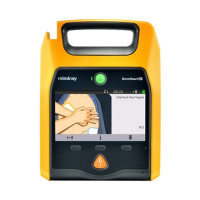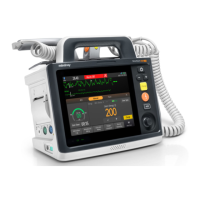Defibrillator/Monitor Operator’s Manual 7 - 1
7 Manual Defibrillation
7.1 Manual Defibrillation Introduction
This chapter explains how to prepare for and perform asynchronous defibrillation and synchronized
cardioversion using electrode pads, external paddles and internal paddles.
In the Manual Defib Mode, you must assess the ECG waveforms, decide if defibrillation or cardioversion is
indicated, select appropriate energy setting, charge the equipment, and deliver the shock. Text messages and a
contact impedance indicator on the screen provide relevant information to guide your throughout the
defibrillation process.
While operating manual defibrillation, besides ECG, you can select to monitor parameters from SpO
2
, NIBP and
CO
2
. Alarms are turned off automatically when you enter the Manual Defib mode. Pressing the Alarm Pause
button on the front panel of the equipment can turn on the alarms.
7.2 Manual Defibrillation Safety Information
• Defibrillation current can cause operator or bystander severe injury or even death. Never touch the
patient or any metal objects connected to the patient (including the bed or gurney) during
defibrillation.
• Avoid contact between parts of the patient’s body such as exposed skin of head or limbs, conductive
fluids such as gel, blood, or saline, and metal objects such as a bed frame or a stretcher which may
provide unwanted pathways for the defibrillating current.
• Do not allow electrode pads and paddles to touch each other or to touch other ECG monitoring
electrodes, lead wires, dressings, etc. Contact with metal objects may cause electrical arcing and
patient skin burns during defibrillation and may divert current away from the heart.
• During manual defibrillation, make sure your hands are dry and free from conductive gel to avoid
shock hazard.
• Use care when operating this equipment close to oxygen sources (such as bag-valve-mask devices or
ventilator tubing). Turn off gas source or move source away from patient during defibrillation. This
can cause an explosion hazard.
• During synchronized cardioversion, if monitoring patient’s ECG through external paddles, artifact
introduced by paddle movement may resemble an R-wave and trigger a defibrillation shock.
• Do not use conductive liquid. Use only conductive gel specified by the equipment manufacturer.
• If external paddles are used for defibrillation, apply the external paddles tightly and evenly to the
patient’s chest to ensure good skin contact.
• Never apply the paddles to human body to verify paddle connection.
• Clinicians must select an appropriate energy level for defibrillation of pediatric patients.
• Never charge and deliver shock frequently in non-clinical situations. Otherwise equipment damage
could occur.

